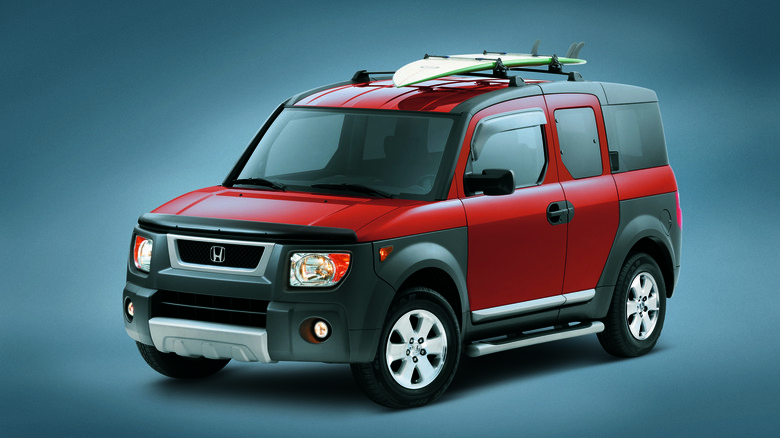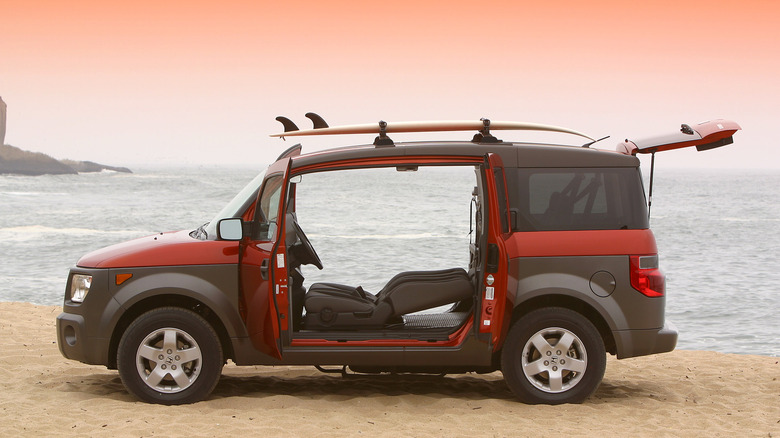Here's Why So Many People Hate The Honda Element
What makes a car "bad" depends on multiple factors, most of which are entirely subjective. Reliability problems and lackluster performance can tilt the scales of public opinion towards a dismal vehicle, but someone somewhere will absolutely adore a vehicle that drew the public's ire. Chrysler's PT Cruiser is often regarded as one of the worst vehicles ever produced, much less one from Chrysler. Yet, despite that status, Chrysler still managed to sell over one million of them during its production cycle and even managed to sell several hundred thousand overseas. That's hardly a failure on Chrysler's part, yet the PT Cruiser is still laughed at in automotive circles. That's almost entirely because the PT Cruiser is not at all a classically good-looking car. At best, it's dorky.
The Pontiac Aztek is a similar case. Underneath the rather bizarre exterior, is a competent, if bland drivetrain that wouldn't be out of place in any General Motors minivan from the time. Honda's box-shaped Element SUV falls into the same unfortunate category as the PT Cruiser and Pontiac Aztek. Its divisive looks far outweigh any of the good things the car had going for it.
Honda's washing machine
The Element is based on a modified Honda CR-V, the brand's stalwart reliable crossover SUV. Mechanically, the Element has practically nothing wrong with it and given Honda's classic dependability and no-fuss ownership experience, the CR-V underpinnings are a plus, if anything. According to a Car and Driver review from 2003, the first year the Element was available, Honda wanted the Element to be the go-to SUV for beachgoers and partyers who didn't mind getting their car dirty and wanted ample room to store tons of stuff like boomboxes (this was 2003 after all), cases of beer, surfing accessories, dogs, tents and whatever else it could fit. On the base trim, the front seats and floormats were waterproof and therefore very easy to clean. On the storage front, the Element performed masterfully as it was capable of storing up to 75 cubic feet of cargo when all the seats are folded down. For comparison, a Toyota RAV4 from the same year had a cargo capacity of only 68.3 cubic feet (via Edmunds)
Where the Element falls apart is in the looks department. It seems to have taken styling cues from both a freight train and a washing machine and the designers were seemingly only allowed to use right angles. Per Honda, the Element was refreshed in 2007, but it was more of an HD Remaster than a new generation. Reviews during the Element's lifespan also mentioned that the Element failed to attract younger buyers and instead skewed towards an older demographic, no doubt cramping the Element's initial style.
The Element's new life
The Element was eventually discontinued in 2011 after receiving a trickle of updates and refreshes during its life here on Earth. According to a press release from Honda, the brand managed to sell over 325,000 from the 2003 to 2011 model years. That's not bad for a toaster on wheels.
After its discontinuation, the Element did not fade into obscurity. It has gained a bit of a second life after its initial demise. Used examples more than a decade old still command a relatively high price (via Kelley Blue Book). The quirky styling was obviously a plus for some people and there's something to be said about simple no-nonsense that won't let you down and can handle all sorts of wear and tear.
The Element is a classic example of the "beauty is in the eye of the beholder" cliche. To the public, the Element was a weird angular cardboard box for retirees, to others, it was the perfect SUV for camping on the beach.


